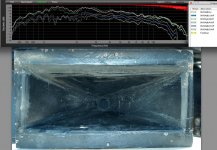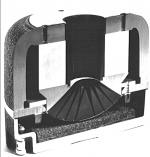It can never be anything but a parabolic (or whatever shape you choose) transition to conical, unless you rebuild the horn, extending it to the driver exit dimension so the horn starts and stays conical.
Agreed.
This is why I use Pyle and QSC now.
Getting that throat right is critical, and if you screw it up, the frequency response just won't match from side to side.
It can never be anything but a parabolic (or whatever shape you choose) transition to conical, unless you rebuild the horn, extending it to the driver exit dimension so the horn starts and stays conical.
Even the 11deg conical (comp's inner horn) transition to 45/55deg conical flare represents an abrupt change in flare rate itself. Optimally the throat area should transition linearly from 11deg...12deg...13deg... to 45/55 deg at the throat to avoid diffraction.
See posts 7-8: Factors Affecting Sonic Quality of Mid & HF Horns & Waveguides
Pure conical or parablic throat does not propably have the best freq response, but the acoustic distortion in smaller with big throat geometries.
These horns sounded natural, accurate and "unrestricted" even without any throat treatment, I don't want to lose that. I suspect the throat area/expansion rate in general is critical to determine if the horn has "pipe" coloration in human voices or not. I don't want to go over board in suppressing the throat area.
Injections ports' location is optimizet to this apex, so I will do whatever transition to the current throat to keep things simple.
Last edited:
This is how the throat looks after treatment #5. The transition is starting to feel quite ok, when "feeling" it from the comp's injection hole.
An externally hosted image should be here but it was not working when we last tested it.
Legis,This is how the throat looks after treatment #5. The transition is starting to feel quite ok, when "feeling" it from the comp's injection hole.
It no doubt has a smoother "feel" but there still is a diffraction producing throat to horn transition, then a parabolic to conical reduction, as can be seen in the "side view" depiction below.
Art
Attachments
Legis,
It no doubt has a smoother "feel" but there still is a diffraction producing throat to horn transition, then a parabolic to conical reduction, as can be seen in the "side view" depiction below.
Art
So the 'trick' would be to move the compression driver back an inch or two.
But that may likely make the taps too far to "reach" the compression driver.
Legis is using DSP, it has plenty of "reach" to compensate for another few inches of distance difference between the 15" taps and the 2446 throat.So the 'trick' would be to move the compression driver back an inch or two.
But that may likely make the taps too far to "reach" the compression driver.
Legis,
It no doubt has a smoother "feel" but there still is a diffraction producing throat to horn transition, then a parabolic to conical reduction, as can be seen in the "side view" depiction below.
Art
Hi Art, I planned to to do a something like this, in the same ballpark. The picture has exaggerated apex size and 3 different "conical to conical" transitions, depenging how far you want to fill the throat. (Right now it still resembles more of a parabolic than conical transition, somewhere in between.)
An externally hosted image should be here but it was not working when we last tested it.
Last edited:
As I mentioned in #230, (and 296, etc.) approximating the Hughes Quadratic Throat transition would solve your problem, the other transitions you picture all go the wrong way, going from a narrow throat, to a much wider angle, then reducing the angle. That, unfortunately, is still "turd polishing".Hi Art, I planned to to do a something like this, in the same ballpark. The picture has exaggerated apex size and 3 different "conical to conical" transitions, depenging how far you want to fill the throat.
That said, you were pleased with the response before all the goop work, so like the song goes, "don't worry, be happy" 🙂.
Art, have you listened and measured different throat transitions with a same horn? Diffraction in only one point of view.
Different throat transitions make for different horns.Art, have you listened and measured different throat transitions with a same horn? Diffraction in only one point of view.
I have on occasion mounted a 1" exit driver on a 2" horn without an adapter, it sounded bad, using a 1" to 2" adapter it sounded fine.
I have made several different conical horns approximating the Hughes Quadratic Throat Transition, they all sound good and have uniform horizontal dispersion. I have compared the same driver to a previous horn with diffraction issues, the HQTT sounded more "real".
The measurements below are of a HQTT 90 x 45A horn ("A" for asymmetrical, it points a bit downward when mounted flat) using a JBL 2420 (near the same throat angle as your JBL) with an aftermarket titanium diaphragm. The driver pictured on the 9045A is a BMS, not the JBL.
Art
Attachments
Hi Y'all,
Does somebody know what the throat angle of the JBL 2446 is?
Regards,
Hi, see this post from Art: http://www.diyaudio.com/forums/subwoofers/258706-study-dipole-cardioid-bass-horn-25.html#post4017963
Different throat transitions make for different horns.
I have on occasion mounted a 1" exit driver on a 2" horn without an adapter, it sounded bad, using a 1" to 2" adapter it sounded fine.
I have made several different conical horns approximating the Hughes Quadratic Throat Transition, they all sound good and have uniform horizontal dispersion. I have compared the same driver to a previous horn with diffraction issues, the HQTT sounded more "real".
The measurements below are of a HQTT 90 x 45A horn ("A" for asymmetrical, it points a bit downward when mounted flat) using a JBL 2420 (near the same throat angle as your JBL) with an aftermarket titanium diaphragm. The driver pictured on the 9045A is a BMS, not the JBL.
Art
Slow flare rate/pipe-ish section at the throat causes the most acoustical distortion, and to my ears, can cause also a slight feeling with for example human voices that the sound is coming "through a pipe". Faster flare rate at throat (parabolic/conical) has less acoustical distortion and based on my experiences, sounds natural.
Theoretically, if the throat diffraction and variations in the freq response could be kept at minimal (say within 3dB) within the whole coverage of the horn, wouldn't it benefit more to use a smooth parabolic or conical throat transition without any pipe-ish slow flare rate section? Best out of both worlds?
Oliver,Does somebody know what the throat angle of the JBL 2446 is?
I think I may have previously slightly overestimated the throat angle, sold my last 2445 in 1995.
IIRC (we know how reliable that is 😉 ) the 244x all share the same narrow throat angle and depth to the diaphragm for compatibility, you can see the angle on this 2441 cutaway view:
Attachments
Slow flare rate/pipe-ish section at the throat causes the most acoustical distortion, and to my ears, can cause also a slight feeling with for example human voices that the sound is coming "through a pipe". Faster flare rate at throat (parabolic/conical) has less acoustical distortion and based on my experiences, sounds natural.
Theoretically, if the throat diffraction and variations in the freq response could be kept at minimal (say within 3dB) within the whole coverage of the horn, wouldn't it benefit more to use a smooth parabolic or conical throat transition without any pipe-ish slow flare rate section? Best out of both worlds?
Taken to the extreme you just use a flat diaphragm at the throat of the waveguide, and skip the compression driver altogether.
I'm strongly considering that for my next project, not 100% sure if it will work, because a CD allows for a lower xover than a 1" flat tweeter
This wouldn't be much different (if at all) than a dome tweeter in a waveguide.Taken to the extreme you just use a flat diaphragm at the throat of the waveguide, and skip the compression driver altogether.
I'm strongly considering that for my next project, not 100% sure if it will work, because a CD allows for a lower xover than a 1" flat tweeter
This wouldn't be much different (if at all) than a dome tweeter in a waveguide.
A 1" dome tweeter can't get to 20khz on a horn or a waveguide. (a 3/4" can.)
This is simple geometry; the apex of the tweeter is out of phase with the edge.
This is not an issue with a flat disc.
Or better yet, a ring.

If you take a close look at the dome tweeters that JBL uses in their waveguides you'll notice the following:
1) Their domes are flattened. This gets you closer to a disc.
2) On some of their domes, there's a phase plug. This 'masks off' the apex, and gets the radiator shape closer to a ring by masking off the apex of the dome.
Last edited:
The long, narrow throats popular from the Webster horn equation days are largely a thing of the past, most drivers are now made "pancake" style, the diaphragm area being compressed to the exit size, and the horn itself using whatever throat transition deemed appropriate by the designer.Slow flare rate/pipe-ish section at the throat causes the most acoustical distortion, and to my ears, can cause also a slight feeling with for example human voices that the sound is coming "through a pipe". Faster flare rate at throat (parabolic/conical) has less acoustical distortion and based on my experiences, sounds natural.
Theoretically, if the throat diffraction and variations in the freq response could be kept at minimal (say within 3dB) within the whole coverage of the horn, wouldn't it benefit more to use a smooth parabolic or conical throat transition without any pipe-ish slow flare rate section? Best out of both worlds?
There is still a "catch 22", longer throats cause more distortion at very high SPL where air becomes non linear (above 160 dB or so), but make for more low end output sensitivity, reducing drive level needed compared to rapid expansions. You can't win...
Hi Legis and Art,
Thanks for the re-direct and the picture.
It would be nice to know the throat angle from a design point of view, as the quality of the transition depends on melding the two different flare ratios. But this may be largely accademic.
Regards,
Thanks for the re-direct and the picture.
It would be nice to know the throat angle from a design point of view, as the quality of the transition depends on melding the two different flare ratios. But this may be largely accademic.
Regards,
My horns open slightly less than 55x45deg, but that's close enough.
I'm not sure if the inner flare is the same between the two JBL drivers.
I think I have read somewhere that the inner horn expand from 1,5" to 2" between it's distance.
With eye I would estimate that the phase plud ends/inner horn starts quite near where the top plate starts. Thus the inner horn might be around 59mm long in 2446: https://www.jblpro.com/pages/pub/components/2446.pdf
The angle can be calculated from that. It is around 11,5deg, if the inner horn is 38mm at the start 50mm at the end, and 59mm long.
I'm not sure if the inner flare is the same between the two JBL drivers.
I think I have read somewhere that the inner horn expand from 1,5" to 2" between it's distance.
With eye I would estimate that the phase plud ends/inner horn starts quite near where the top plate starts. Thus the inner horn might be around 59mm long in 2446: https://www.jblpro.com/pages/pub/components/2446.pdf
The angle can be calculated from that. It is around 11,5deg, if the inner horn is 38mm at the start 50mm at the end, and 59mm long.
An externally hosted image should be here but it was not working when we last tested it.
- Status
- Not open for further replies.
- Home
- Loudspeakers
- Subwoofers
- Study of a Dipole/Cardioid Bass Horn


